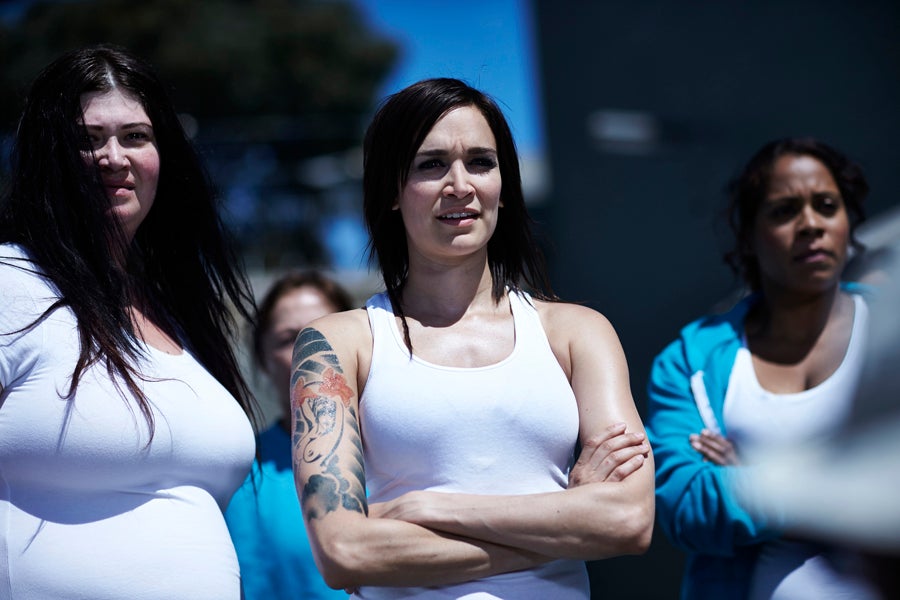Wentworth Prison and the real-life parallels for locked-up women
The question of why we continue to lock up some of the most vulnerable and damaged women in society for relatively petty offences has yet to be answered

They say good girls go to heaven and bad girls go everywhere.
If they are really very bad – or perhaps just unlucky – they may find themselves banged up in Wentworth Prison, the titular setting for the “contemporary reimagining” of Australian cult hit guilty pleasure, Prisoner Cell Block H, which opens its high security doors tonight on Channel 5.
Die-hard fans of PCBH, which originally ran from1979-86, will judge for themselves whether sleeping dogs ought to have been left to lie. I confess (without embarrassment) that I was a pretty dedicated fan of the late night reruns of the show, going to bed early for school and setting my alarm for 3am so I could get my fix of Bea, Lizzy, “Vinegar Tits”, et al.
Perhaps I was a slightly unusual teenager, but I was in good company, as PCBH has one of the most loyal fan bases in television history. Sure, it was easy to mock the show for its shaky sets, occasionally bonkers plotlines (especially as the years went by) and cheesy theme tune, but not only was it highly entertaining, it was pretty radical television in its day and certainly feminist in its themes. When it launched, the advertising blurb ran, “If you think prison is hell for a man, imagine what it’s like for a woman”, and its remake comes at a time when UK politicians are finally beginning to seriously question the wisdom of locking up non-violent women offenders, following the recent report by the Commons Justice Select Committee.
Prisons are the ultimate symbol of state control and provide the setting for good stories, endless conflict and memorable characters, so little wonder prison dramas – especially women’s – have proved such a ratings winner over the years, from Tenko through to PCBH, to ITV’s Bad Girls and hit Netflix series, Orange is the New Black. There is an obvious voyeuristic appeal to tales of female incarceration – girl-on-girl action and women fighting – but PCBH was hardly lipstick lesbianism and handbags at dawn catfights between nymphettes. The majority of the characters were unglamorous and the “bashings” were brutal, even murderous.
It was the shockingly realistic portrayal of the female experience of prison which won the show its loyal following, particularly in its early years before its descent into madcap capers and repetitive plots (a route followed some years later by Bad Girls, which began life as gritty social realism, gradually became as camp as Christmas, and ended with a ghost).
PCBH deserves credit for raising awareness of the particular problems faced by female inmates and the reasons why women are locked up in the first place – sexual and physical abuse, poverty, drug and alcohol addiction, mental health problems, self-harm and bullying all featured strongly in the series. Women were shown having their babies prised from their arms, losing custody of their children and taking their own lives, and the problems of recidivism and institutionalisation were examined in many storylines.
The characters may have seemed stereotypical – tarts with hearts, wide-eyed middle-class remand prisoners struggling to make sense of it all, murderers who have their own strong moral code – like Top Dog “Queen” Bea Smith – and a fair few irredeemable sociopaths, but they were recognisable and believable types. Some viewers may have found psychotic screw, Joan “the freak” Ferguson, a tad OTT, but the abuse of powerless, institutionalised women is hardly an unknown phenomenon.
As with all soaps, PCBH offered a heightened form of reality – there were an astonishing number of murders and sieges, but there was nothing much on screen that didn’t really go on inside. Three decades on since PCBH hit our screens and the question of why we continue to lock up some of the most vulnerable and damaged women in society for relatively petty offences has yet to be answered.
According to campaign organisation, Women in Prison, the number of female inmates in the UK increased by 27 per cent between 2000-10. 80 per cent of women inmates are serving time for non-violent offences, with theft and handling by far the most common of their crimes. The majority of female prisoners are themselves victims of serious offences, with the statistics making predictable but depressing reading – more than half have experienced rape, sexual abuse or domestic violence; 10 per cent of women were homeless before entering prison, and one quarter have spent time in local authority care; more than half have a serious mental health condition and one third have had a previous psychiatric admission whilst 37 per cent have attempted suicide prior to entering custody. It was the suicides of six women in Styal Prison which led to the Corstan Review, which in 2007 stated that, “Community solutions for non-violent women offenders should be the norm.”
If these recommendations are ever implemented, it might make for less dramatic television storylines in the future, but could mean happier outcomes for some of the 13,500 real women currently given prison sentences every year in the UK.
Wentworth Prison starts tonight at 10pm on Channel 5

Join our commenting forum
Join thought-provoking conversations, follow other Independent readers and see their replies